Motorola Moto G Review
by Brian Klug on December 18, 2013 2:00 PM EST- Posted in
- Smartphones
- Motorola
- Mobile
- *VA
- Cortex A7
- snapdragon 400
- Moto G
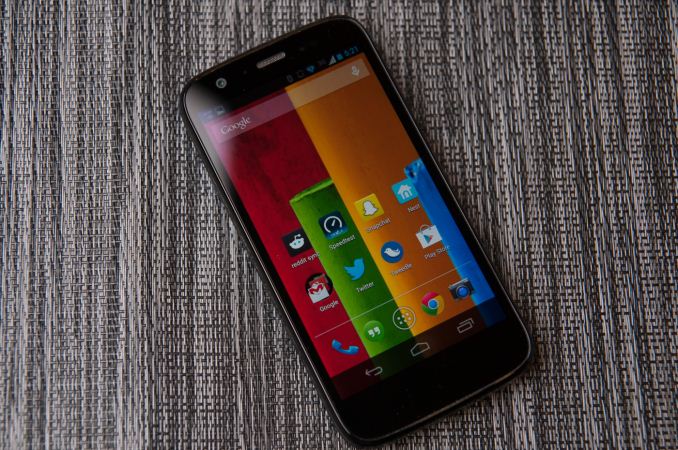
I like what the new Motorola is doing. It seems like an eternity ago, but I remember when phone launches with Motorola meant a variety of variants all with their own idiosyncrasies. Since re-launching itself, Motorola has launched just two new lines of device – the higher end Moto X, and its mass-market cousin, the Moto G which we’re taking a look at. That’s a bit of a simplification, as Motorola is still selling five Droid-branded handsets, but it’s a huge consolidation that’s much easier to follow.
The Moto G’s goal is pretty simple – to deliver an affordable smartphone experience that doesn’t make any sacrifices in something close to the Moto X’s form factor. It’s an ambitious goal that goes right after some of the largest growth segments for smartphones internationally. There’s a ton of competition at the top, it’s somewhere in the middle that’s arguably more interesting right now.
G is a popular character right now, LG was arguably first to lay claim to it with its Optimus G, G Pro, G2, and now G Flex brands, so it’s kind of interesting to see Motorola also lay claim to G with the Moto G. Absent any guidance what G actually stands for, I’m going to take a nod from lens reviewer Ken Rockwell and say that G stands for “Gelded” since the Moto G is really a pared down Moto X, but I wouldn’t attach any real negative connotation to the word. The form factor is largely the same, where the Moto G moves down a notch versus the X is in its camera, display size and tech, cellular connectivity, size (it’s slightly bigger), and of course the lack of active display or always on voice activation features. Like any product, it’s just a different set of tradeoffs, this time more optimized for cost.

My T-Mobile Motomaker Moto X (top), Moto G with turquoise back shell
Before I started working on the Moto G, I switched back to the Moto X for a while to refresh my comparison point, right after it got the 4.4 update. Motorola let me build a blue with yellow accents Moto X from Motomaker since I recently switched to T-Mobile and my previous device was locked to AT&T. The comparison point helped me really feel out the physical differences between the Moto X and Moto G. You can tell that the Moto G is slightly thicker almost immediately, the changes in width, height, and mass don’t really stick out as much. I can’t put my finger on it but the curve of the G seems slightly less pronounced as well, although the G is still comfortable to hold. I won’t bore you any further, but the dimensional differences really aren’t that noticeable between the two, I don’t feel like the Moto G’s in hand feel is a regression at all versus the excellent Moto X.
| Moto X | Moto G | |
| SoC |
Qualcomm Snapdragon S4 Pro (MSM8960Pro) 2x Krait 300 at 1.7 GHz Adreno 320 at 400 MHz Motorola X8 System (SoC+NLP Processor+Contextual Processor) |
Qualcomm Snapdragon 400 (MSM8x26) 4x ARM Cortex A7 at 1.2 GHz Adreno 305 at 450 MHz |
| Display | 4.7-inch AMOLED (RGB) 1280x720 | 4.5-inch LCD (RGB) 1280x720 |
| RAM | 2GB LPDDR2 | 1 GB LPDDR2 |
| WiFi | 802.11a/b/g/n/ac, BT 4.0 | 802.11b/g/n, BT 4.0 |
| Storage | 16 GB standard, 32 GB online, 2 years 50 GB Google Drive | 8/16 GB, 2 years 50 GB Google Drive |
| I/O | microUSB 2.0, 3.5mm headphone, NFC, Miracast | microUSB 2.0, 3.5mm headphone |
| OS | Android 4.4 | Android 4.3, 4.4 Early 2014 |
| Battery | 2200 mAh, 3.8V, 8.36 Whr | 2070 mAh, 3.8V, 7.9 Whr |
| Size / Mass | 65.3 x 129.3 x 5.6-10.4 mm, 130 grams | 65.9 x 129.9 x 6.0-11.6 mm, 143 grams |
| Camera |
10 MP Clear Pixel (RGBC) with 1.4µm pixels Rear Facing 2 MP 1080p Front Facing |
5 MP w/AF, LED Flash 1.3 MP front facing |
| Price | $199 (16 GB), $249 (32 GB) on 2 year contract | $179 (8 GB), $199 (16 GB) no contract |
If you’ve held the Moto X, the Moto G is immediately familiar. For those that haven’t, the two share what’s probably the best balance of size and form factor among Android handsets right now – Moto G is just a bit thicker around the waist.
On the front the Moto G eschews the “magic” fused glass-plastic top layer. For those unaware, one of the standout features of the Moto X was this seamless (well, relatively seamless) transition from glass to plastic along the edge, which really did make it more comfortable to use. Moto G uses the more pragmatic lip and sunken glass approach, and the sample I was provided has a bit of a gap between the two where dust can gather and show. Not a big deal but worth noting as one of the few visible differences. The Moto G still does have some nice lips that prop the display up so you can lay it display-first on a flat surface without worrying about scratching the display.
The Moto G uses the same button and port placement as the Moto X, which I won’t go over. The buttons feel nice and solid as well, not cheap and flimsy. The speakerphone grille moves to the opposite side, but camera and flash positions remain unchanged. The motorola logo and accompanying dimple also don’t go away.
Impressively, Moto G also doesn’t eschew dual microphones for in-call background noise cancelation. There’s a primary microphone at the bottom, and secondary up top. Moto X had a bottom front, bottom back, top side arrangement, so technically Moto G has one fewer microphone, but having dual mic noise suppression is a noteworthy feature at this price point.
The most dramatic change between the two of course is the removable back door, which doesn’t work so much as a door for the battery as it does gate access to the microSIM slot and add an opportunity for adding a touch of customization with a colored or flip shell. As an aside, it’s odd to me that the Moto X embraced nanoSIM (4FF) yet the Moto G that launches after it goes with microSIM (3FF). It’s possible some of the operators or markets Motorola has in mind for the Moto G haven’t yet made nanoSIMs readily available. There’s a big sticker on the back noting that the battery isn’t replaceable, I’m reminded of the Droid 4 which also included a removable back and a big sticker, but no removable battery.
Motorola sent a turquoise colored snap-on shell in addition to a blue flip shell to check out on the Moto G. By default the phone comes with a black shell, but there are six different color shells you can choose from, in those two (flip and non-flip) varieties. I appreciate how much even something like this helps differentiate the Moto G versus competition that comes in at best maybe two or three colors. The materials, fit, and finish on the two snap covers I was sent seem excellent. I have no complaints, there’s no creaks or gaps to speak of. Shells run $14.99, flip shells cost a twenty bucks more at $34.99.
The flip cover nails it though, there’s a magnet inside to both keep the cover shut and in place when closed, and another ostensibly for signaling open and closed status – Moto G turns on automatically when opened, and shuts off when closed. Those two features should be requisite for anyone even thinking of bundling a flip cover as a first party accessory at this point, and I’m impressed to see them on this device at that price point.
Inside the relatively small Moto G box you don’t get much in the way of extra stuff. There’s no bundled USB wall charger or pack-in headphones, just a USB cable. I’m awash with USB chargers so I don’t mind OEMs saving the extra few dollars by not including an extra one, in the case of Moto G at least that savings seems to actually get passed on to the customer. I’ll talk about it in the charging section but Moto G seems well behaved with a variety of USB power sources, thankfully.
Moto G doesn’t try to push industrial design somewhere crazy, and obviously at the price point that it’s coming in at, it can’t really afford to. Solid execution which doesn’t deviate a lot from Moto X and good overall construction are the real highlights.


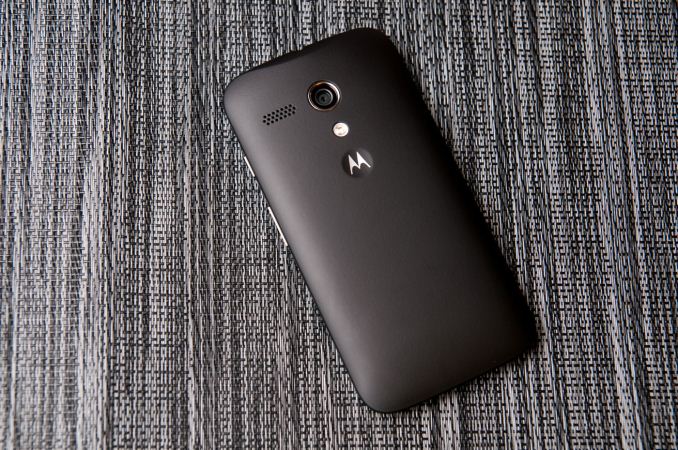
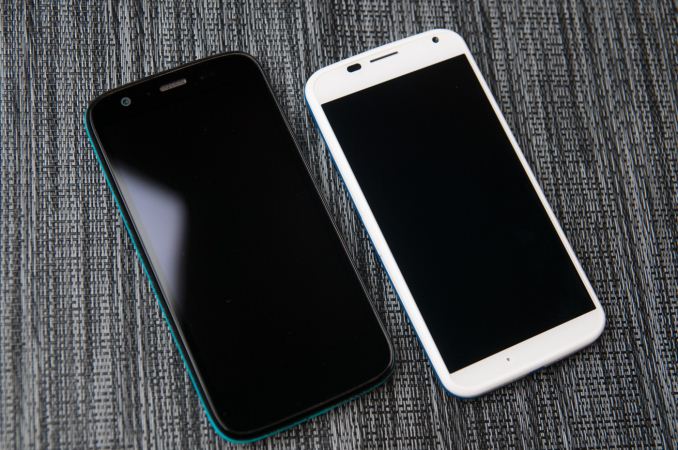






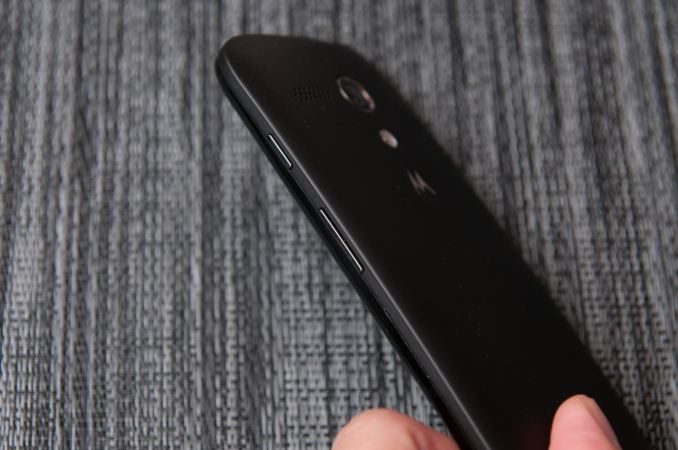
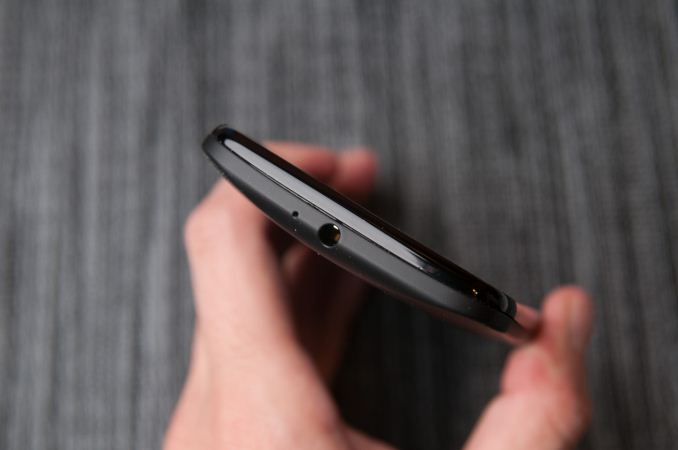
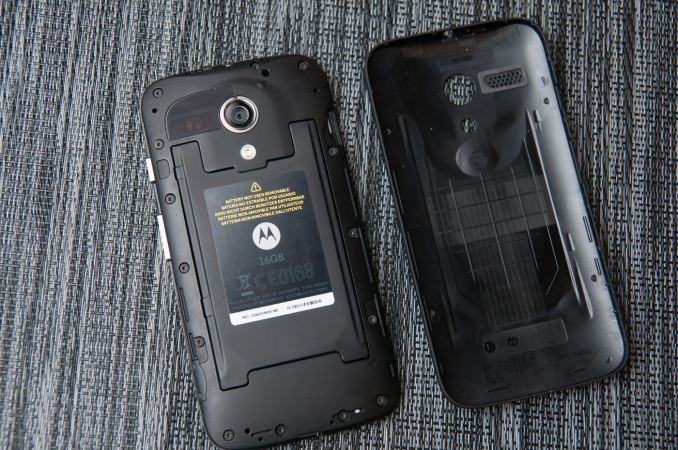
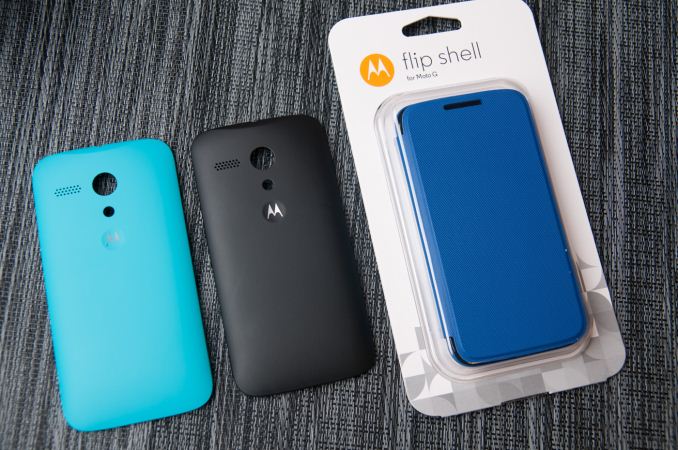
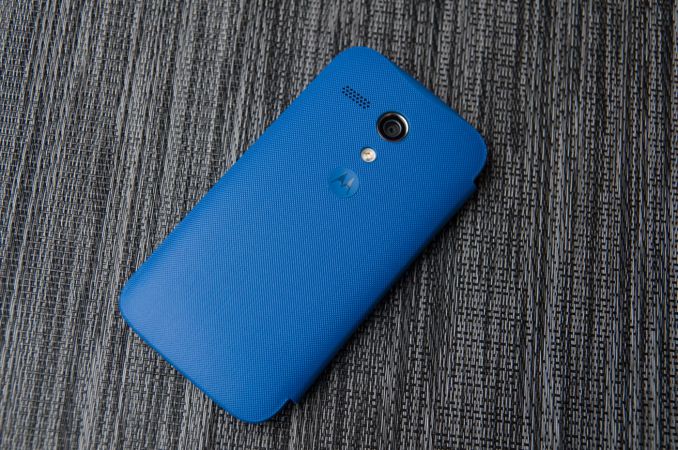








120 Comments
View All Comments
uhuznaa - Wednesday, December 18, 2013 - link
Even my 8 GB Nexus 7 has a two GB left. Lots of storage is convenient for the lazy and the horders, but in now way something that makes or breaks a device for "normal" use. "3-4 GB of music" is about 1000 songs. Yeah, more is better, always, but don't make this into more of a limitation than it actually is. Most people don't care very much anyway.apertotes - Wednesday, December 18, 2013 - link
a tablet is not at all like a phone. a tablet sits at home mostly, with WiFi and instant access to hundreds of online services. A phone goes with you everywhere, even places without -gasp- internet. And most people care, indeed, and that is why they buy galaxies instead of ones.Bob Todd - Wednesday, December 18, 2013 - link
Do you have any proof that the majority of Galaxy S* buyers do so because of micro-SD or removable batteries? Survey data from a reasonable cross section of buyers? I like both of those features, but the idea that it is the main driver of Samsung's success with that line doesn't seem to be grounded with any facts. I'd assume marketing plays the biggest role, along with actually building a solid brand behind it (one high end line available on most major carriers updated once per year). Yes some % of users care a great deal about removable storage and removable batteries, but if you think that's the secret to their success I think you are deluding yourself. And I'm almost sorry I responded at all to the inevitable whining about removable storage. There are other cheap devices that offer those features, be happy that a quality option is available at this price point.apertotes - Wednesday, December 18, 2013 - link
Well, HTC thought the same last year, after their beautiful HTC ONE X beat the Galaxy S3 in every review, but lost badly on sales. "It's the marketing!". They lost another good year blaming marketing, and now are even in worse situation than a year ago. Or do you want to convince me that HTC is not a strong brand? Or Blackberry, for what it is worth.Yes, Samsung sells lots of Aces very cheap, but S3 and S4 and Notes are not cheap. And they outsell almost the rest of high end android devices combined. I really do not think that Samsung is that good at marketing.
Impulses - Wednesday, December 18, 2013 - link
Nope, HTC isn't a very strong brand outside of tech enthusiasts. Samsung/Galaxy is a lot more easily recognized... I had three HTC phones in a row (all the EVOs), very early random people would ask me if they were "the new iPhone" (never mind the massive size difference). Later on most friends would ask "did you get a Galaxy?" when they'd see I have a new phone, never mind it says HTC front and center...Samsung is ABSOLUTELY that good at marketing, have you watched network TV or looked at print magazines lately? Geeks may not do that much anymore but the general public does and Samsung's ad campaign is all over that media, it's impossible to ignore.
sajara - Saturday, December 21, 2013 - link
Indeed you're absolutely right. Samsung is a very powerful brand just about everywhere due to marketing. That, produces free publicity through brand awareness and then word of mouth. Even in the Dominican Republic a (developing country) where i go regularly, a sacred Blackberry land, is buying in bulk Galaxy(s) and why? Huge billboards everywhere and all 4 carriers selling just about every model.sajara - Saturday, December 21, 2013 - link
I was referring to Impulse's post btw...Bob Todd - Wednesday, December 18, 2013 - link
Again, what proof do you have to the contrary? Like I said, I'm sure some % of their user population does buy the Galaxy line _specifically_ for micro-SD and a removable battery. But I'd put a decent chunk of change on the size of that % being 1 in every 5 buyers or less. You think all those buyers of a mainstream device (who have no idea what SOC is in their phone or even what a SOC is) are walking into their carrier's stores with a 64GB micro-SDXC card full of stuff? There is a lot more to the success of the Galaxy line than removable batteries and expandable storage.apertotes - Wednesday, December 18, 2013 - link
I do not need to give any proof at all. I am not in the industry, and I could not care less. But it is funny watching people that should really know about this stuff (like HTC spokesperson) blame it all on marketing time after time, and get worse results every year.Also, HTC is a very strong band. A few years ago it was almost a synonym of smartphone, and they also spend a lot of money on advertising and sponsorships.
Anyway, do you have any proof that micro-sd cards are not a strong reason behind massive galaxy sales?
martajd - Wednesday, December 18, 2013 - link
"I don't need to give any proof." Yeah, you do